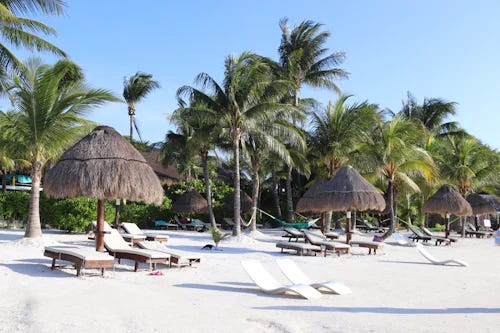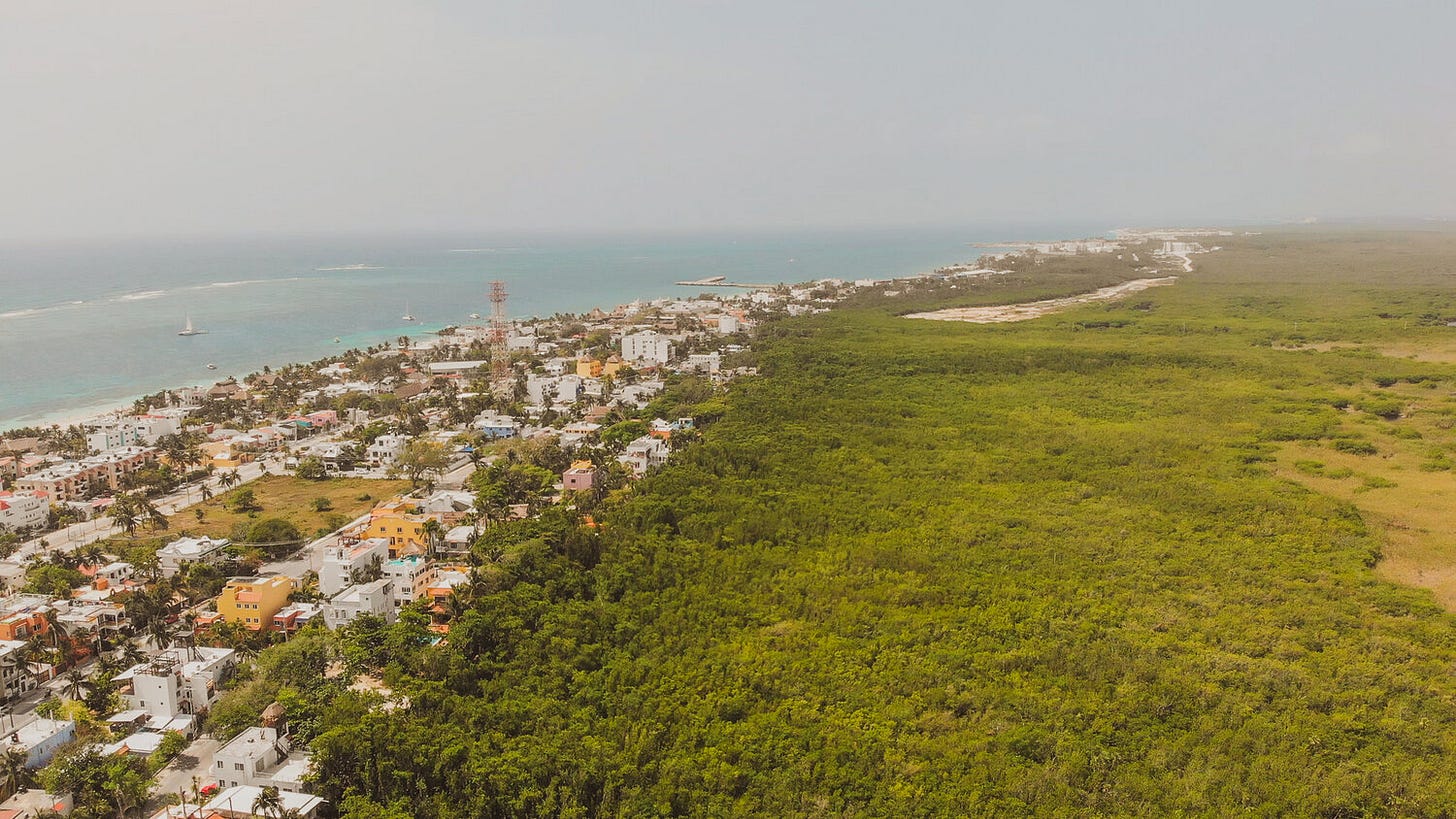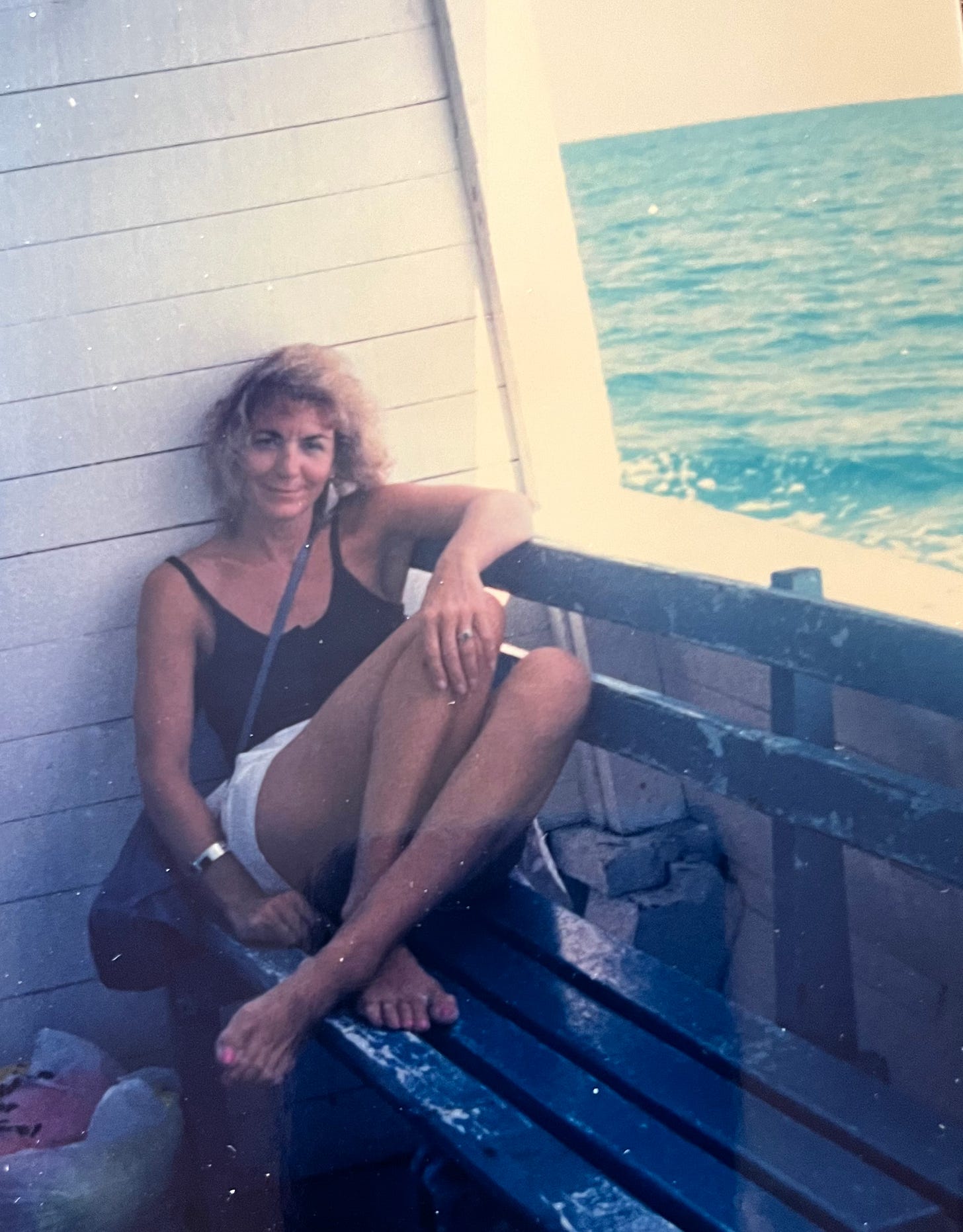Mexico Soul presents a condensed version of Where the Sky is Born, my travel memoir on building a house and opening a bookstore. Earlier chapters in menu above.
After meeting a potential contractor our first day back in Puerto Morelos, we hopped in the rental car and headed north to look at a beachfront lot for sale. On the rural road, a strange quiet came over me; seeing so much devastation was numbing. I was shell-shocked from viewing Hurricane Gilberto’s wrath up close and Paul was as thoughtful as I.
Two lots north of Barry’s a 12-unit condo complex had recently been built. Like his, it was peeled in half, gaping open. Now it stood as forlorn as Barry’s.
“Just keep driving,” I said. “You can’t look back.”
There was little that could be done to help the situation on the coast that day or any day immediately following the storm. I knew however that should we ever manage to build a house in this incredibly beautiful place, buying house insurance would be first on my to do list.
On the bumpy road we passed the crossroad for Crococun, a live crocodile farm and zoo. Crococun housed a minimal number of reptiles before the hurricane and now there were none. Every single snake and crocodile escaped during the storm. When the force of nature freed them, the caged animals dashed towards the sea, reminiscent of some Paleozoic evolutionary survival pattern.
Along with the reptile escape we heard a story about a local innkeeper, Ana Mario Almada of Amar Inn, and how she’d come back to town after evacuating like everyone else, only to find her cabañas torn to pieces. A striking woman in her 60s, she and her husband left central Mexico and re-settled on the Quintana Roo coast to open a small hotel.
In a moment of introspection after viewing Gilberto’s destruction, she prayed for a sign. Should she stay or pull up stakes? While repairs were being made on their home, she and her husband stayed with friends who lived near the crocodile farm. One day as she walked downstairs to the yard she stepped on a cuatro narices, a deadly viper known as a four-noser. It bit her on the foot. Local lore said after their bite you’d be dead in 15 minutes without injecting the antidote—their poison worked that rapidly.
A snake in the grass
As Ana Mario grabbed her foot, she cried out, “Something bit me!”
Two near-by Maya workers ran towards her. One held her up attempting to look for the injury while the other scouted the brush looking for the snake. Luckily it was captured and identified and Ana Mario was given charcoal to neutralize the venom. By this time her husband was at her side. Moments later a friend arrived and drove them to the makeshift clinic in Puerto Morelos where she was given an anti-toxin shot.
Everyone assumed the cuatro narices was a renegade from Crococun but that mattered not. Her body was reacting and she continued to swell as the venom took hold. Their friend drove them to Cancun where a hospital administered another shot. Then they drove to Merida, two hundred miles away, for more advanced treatment. At the Merida hospital, her body continued to swell, but the doctor told her husband she would make it. Luckily, he explained, she was wearing huaraches, the Mexican sandals with the tire-tread sole. Due to the thickness the snake only punctured her with two fangs rather than four.
Her daughter, Ana Luisa, arrived in Merida the next day and waited for her mother to convalesce. A few days later when she was ready to be released, Ana Luisa questioned her mother about the bite, asking if it was the sign she’d been waiting for.
“I was given a sign. . .”
“Yes,” the woman responded, her voice still subdued. “I was given a sign.”
“I agree,” her daughter said. “The snake bite was enough to make us all want to leave this place.”
“Oh, no. The snake bite was the message that my place is here. Here is where I survived and here is where I will stay.”
Others may have viewed God’s handiwork differently but the innkeeper had been right about finding her place. Ana Mario Almada founded the ecological group, Lu’um Ka’naab, that fought to preserve the Palancar Reef (later renamed Great Mesoamerican Reef thanks to her efforts), the second largest coral reef in the world spanning 625 miles of coastline, a half mile off Puerto Morelos’ shores.
Because of her and Ana Luisa’s hard-nosed perseverance, Puerto Morelos was named a national ecological park by the Mexican government in 1998. Through their efforts the mangroves surrounding the town were also deemed preserved, similar to a much publicized project in Florida’s Everglades. Ana Mario knew how grave the reef’s existence was to both the locals and the ocean environment and that 80 percent of its living coral had already been lost or degraded by pollution, overfishing, or storms.
Cruising down the sascab road for another 10 minutes, we located the second lot Rodolofo told us about. After a closer look, we decided we preferred his first choice and headed back to town.
You couldn’t walk two feet in Puerto Morelos without hearing a far out story
That night we dined at Posada Amor, the old love-in cabañas and restaurant located on the town square. The local story was the owner had become infatuated with the hippie movement and had dedicated his cabañas to the concept of spiritual love. At one end of the white-washed dining room a small shrine for him had been erected. You couldn’t walk two feet in Puerto Morelos without hearing some far out local story.
The next morning we asked the hotel clerk if her husband, Rodolfo, was home. She said he’d gone to Cancun and asked what we needed. We said we wanted to discuss both lots and the building project and she suggested we see his business partner, Joe Marino, since he wouldn’t be back until late that day.
“Have you seen the large white house with the weather vane and rounded staircase?”
Paul and I exchanged a glance. On our many trips to Puerto Morelos we often fantasized about who lived there. Apparently we were going to find out.
“Joe Marino?” Paul asked.
“Yes, we’ve known him a long time. His family has been coming here since before we built the beach cabañas 15 years ago. Their house is right next to the Maya Yoga Center. Do you know where that is?”
“Yoga in Mexico?”
“Oh, it’s very popular here, and so is meditation,” the clerk assured me.
Puerto Morelos was a speed bump on the road to spiritual development
Over the years as we grew to know Puerto Morelos better we noticed it had a cosmic draw for psychics, healers, artists and occasionally the offbeat traveler. In time came aura readers, drummers, jungle journeyers and Maya calendar devotees. Even being way down south in Mexico, we still captured the cosmic crowd. Puerto Morelos was a speed bump, a tope, on the road to spiritual development for many.
Why Puerto Morelos? A modern Maya goddess explained it like this: For over a millennium Maya women used this coastal port as a place to congregate before journeying to the island Cozumel, considered a fertility site blessed by the goddess Ixchel. In the Maya pantheon, Ixchel was the moon goddess and also patroness of pregnancy, wrote Maya scholar Sylvanus Morley in The Ancient Maya.
A gathering spot for women awaiting passage to Cozumel
From the shores of Puerto Morelos women awaited passage to Cozumel. From here their spiritual journey began—no doubt it was a place incantations had been made. It drew ancient Maya then, the goddess said, and it was still pulling those with a spiritual craving to its shores now.
How appropriate we should land here, I thought. Even though I’d put my meditation mode on automatic pilot when I joined the ranks of the seriously employed in San Francisco, finding my spiritual place in the world had always been a focus of my adult life. Making money happened almost as a sideline, but it afforded me the gift of being here, in this spot, now.
And if you’re interested in supporting independent journalism and writing, please consider a paid subscription to Mexico Soul. It would mean the world to me and will keep you up to date on all my posts and chapters from Where the Sky is Born, detailing how we bought land and built a house in a small fishing village on the Mexico Caribbean coast. Not to mention a bookstore, too! All for $5/monthly or $50 per year.











What a wonderful and magical chapter in your Puerto Morelos journey! Such a pleasure to see the richness of the Yucatan unfold through your writing. Well done, and thank you!
Once again my friend you've outdone yourself. I was wondering what Book to bring on my vacation, Now I know. I read it years ago, When you gave it to me and I was visiting all the lighthouses on the west coast. Now, I'll enjoy it on my travels to South Dakota. Where; Hopefully there are many arms To hug me when I arrive.
Keep on writing my friend, you're fantastic.
💜🐟🐠🐡🐈🐈 those darn cats just won't stop chasing the fish.